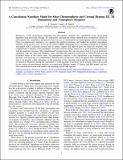A cancellation nanoflare model for solar chromospheric and coronal heating. III. 3D simulations and atmospheric response
Abstract
Inspired by recent observations suggesting that photospheric magnetic flux cancellation occurs much more frequently than previously thought, we analytically estimated the energy released from reconnection driven by photospheric flux cancellation, and propose that it can act as a mechanism for chromospheric and coronal heating. Using two-dimensional simulations we validated the analytical estimates and studied the resulting atmospheric response. In the present work, we set up 3D resistive MHD simulations of two canceling polarities in a stratified atmosphere with a horizontal external field to further validate and improve upon the analytical estimates. The computational evaluation of the parameters associated with the energy release are in good qualitative agreement with the analytical estimates. The computational Poynting energy flux into the current sheet is in good qualitative agreement with the analytical estimates, after correcting the analytical expression to better account for the horizontal extent of the current sheet. The atmospheric response to the cancellation is the formation of hot ejections, cool ejections, or a combination of both hot and cool ejections, which can appear with a time difference and/or be spatially offset, depending on the properties of the canceling region and the resulting height of the reconnection. Therefore, during the cancellation, a wide spectrum of ejections can be formed, which can account for the variety of multi-thermal ejections associated with Ellerman bombs, UV bursts, and IRIS bombs, and also other ejections associated with small-scale canceling regions and spicules.
Citation
Syntelis , P & Priest , E R 2020 , ' A cancellation nanoflare model for solar chromospheric and coronal heating. III. 3D simulations and atmospheric response ' , Astrophysical Journal , vol. 891 , no. 1 , 52 . https://doi.org/10.3847/1538-4357/ab6ffc
Publication
Astrophysical Journal
Status
Peer reviewed
ISSN
0004-637XType
Journal article
Description
This research has made use of NASA's Astrophysics Data System. This work was supported by computational time granted from the Greek Research and Technology Network (GRNET) in the National HPC facility ARIS. P.S. acknowledges support by the ERC synergy grant "The Whole Sun."Collections
Items in the St Andrews Research Repository are protected by copyright, with all rights reserved, unless otherwise indicated.
Related items
Showing items related by title, author, creator and subject.
-
Solar cycle variation of photospheric and chromospheric magnetic and ultraviolet emission features observed by the Solar Dynamics Observatory
Noble, Callan Nicholas (2022-11-29) - ThesisThe solar magnetic field exhibits cyclic behaviour over a period of 22 years, continually reprocessing the poloidal, dipolar magnetic field into toroidal, quadrupolar magnetic field and vice versa. The cyclic behaviour of ... -
Probing the physics of the solar atmosphere with the Multi-slit Solar Explorer (MUSE). I. Coronal heating
De Pontieu, Bart; Testa, Paola; Martínez-Sykora, Juan; Antolin, Patrick; Karampelas, Konstantinos; Hansteen, Viggo; Rempel, Matthias; Cheung, Mark C. M.; Reale, Fabio; Danilovic, Sanja; Pagano, Paolo; Polito, Vanessa; De Moortel, Ineke; Nóbrega-Siverio, Daniel; Van Doorsselaere, Tom; Petralia, Antonino; Asgari-Targhi, Mahboubeh; Boerner, Paul; Carlsson, Mats; Chintzoglou, Georgios; Daw, Adrian; DeLuca, Edward; Golub, Leon; Matsumoto, Takuma; Ugarte-Urra, Ignacio; McIntosh, Scott W.; the MUSE team (2022-02-11) - Journal articleThe Multi-slit Solar Explorer (MUSE) is a proposed mission composed of a multislit extreme ultraviolet (EUV) spectrograph (in three spectral bands around 171 Å, 284 Å, and 108 Å) and an EUV context imager (in two passbands ... -
The magnetically quiet solar surface dominates HARPS-N solar RVs during low activity
Lakeland, Ben S; Naylor, Tim; Haywood, Raphaëlle D; Meunier, Nadège; Rescigno, Federica; Dalal, Shweta; Mortier, Annelies; Thompson, Samantha J; Cameron, Andrew Collier; Dumusque, Xavier; López-Morales, Mercedes; Pepe, Francesco; Rice, Ken; Sozzetti, Alessandro; Udry, Stéphane; Ford, Eric; Ghedina, Adriano; Lodi, Marcello (2024-01-01) - Journal articleUsing images from the Helioseismic and Magnetic Imager aboard the Solar Dynamics Observatory, we extract the radial velocity (RV) signal arising from the suppression of convective blueshift and from bright faculae and dark ...

